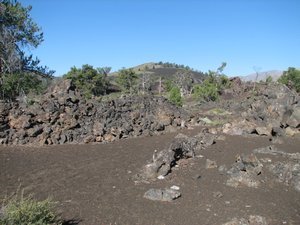Advertisement
Published: August 31st 2009

 The Campground
The Campground
The campsites looked like they had been carved out of the lava flow.We’ve seen many of the “badland” areas of the western US, but what we found in central Idaho is like nothing we have ever seen. The Craters of the Moon National Monument and Preserve near Arco, ID contains over 1,100 square miles of protected area, mostly lava fields resulting from volcanic activity from as far back as 15,000 years age and as recent as 2,000 years ago. The resulting effect is black rocky “moonscape” for as far as the eye can see. (Actually, scientists say it more closely resembles Mars.) There is one paved loop in the northwestern corner of the preserve, the rest of the preserve being inaccessible by auto. There is a campground on the loop and several paved footpaths leading to various caves and unusual rock formations.
We went to the Preserve with Bill and Ginger Dallas, old friends of ours from Atlanta, who had come by to visit us on their vacation. We took several of the walking tours, and were impressed at how desolate and forbidding the landscape was. We were amazed to find that, in spite of the inhospitable conditions, some plant life managed to survive, including some very delicate and pretty flowers.
The highlight

 Desert Flower
Desert Flower
This pretty flower was right in the campground. It looked so out of place among all the black rocks.of the tour was Indian Tunnel, an 800-foot long lava tube (cave) accessible only after a mile-long hike. Steps led down to the rock-strewn floor of the tube some 30 or 40 feet below ground level. The cave was very quiet, and dimly lit by sunlight filtering through scattered holes in the cave ceiling. It was a little bit eerie, and we were periodically startled by the sudden flight of birds spooked by our presence. The whole thing was a surreal experience, unlike anything we had ever experienced. Back at the campground, we discussed it all over a beer during happy hour, and agreed that the experience was interesting, but not something we would ever want to do again.
The trip back to our home base brought us over the Perrine Bridge, which takes US 93 over the Snake River Canyon on the east side of Twin Falls, Idaho. At the time the original bridge was constructed in 1927, it was the highest bridge in the world (500 feet above the river). Today, the bridge is the only man-made structure in the U.S. where unrestricted BASE jumping (parachuting) is allowed, and is a favorite among BASE jumpers. It is also

 Sparse Vegetation
Sparse Vegetation
This was taken along one of the footpaths. It's tough being a tree in this environment.the site of one of Evel Knievel’s most spectacular stunts. On September 8, 1974 he attempted to jump the canyon on a jet-powered motorcycle. The plan was to jump the canyon and deploy a parachute to drop the cycle and passenger safely on the other side. The parachute malfunctioned and opened early, and even though he had crossed the canyon in the air, the wind caused him to drift back into the canyon. He landed on the rocks at the edge of the river and walked away without serious injury, but very fortunate not to have drowned in the river.
There is a parking lot and observation deck next to the bridge, so we stopped to take some pictures. It’s a pretty interesting place.
Advertisement
Tot: 0.081s; Tpl: 0.011s; cc: 12; qc: 30; dbt: 0.0504s; 1; m:domysql w:travelblog (10.17.0.13); sld: 1;
; mem: 1mb

 The Campground
The Campground
 Desert Flower
Desert Flower
 Sparse Vegetation
Sparse Vegetation








